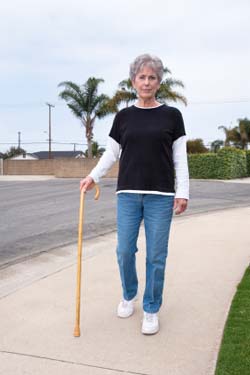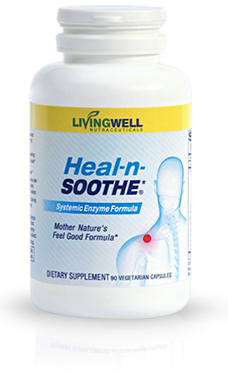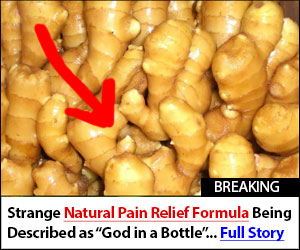
Take These 7 Steps Now to Prevent a Broken Hip
The 7 Key Steps
I once asked my grandmother what she thought was the best way to prevent a broken hip.
She immediately responded, “Don’t fall in the first place!”
While her response may have been sarcastic, she has a point. The most common cause of a fractured hip is taking an unexpected tumble.
Unfortunately, this type of accident is becoming ever more common – and has more serious consequences than you might think.
The American Academy of Orthopedic Surgeons (AAOS) reports that hip fractures may soon become an epidemic as a large percentage of the population grows older. There were approximately 368,000 broken hip cases in 2006; that number is expected to nearly double to 650,000 by 2050.
Unfortunately, this common injury can actually be life threatening. Most hip fractures require hospitalization, surgery, and a long recovery period. Worst of all, 24% of patients over 50 years old with a hip fracture passed away within one year of their accident, due to complications and a long recovery period.
You may be surprised that there are more ways to prevent a broken hip than cleaning up the floor. Here are the top seven ways to prevent a broken hip.
Prevention on the Home Front
Because the majority of falls occur in the home, it’s prudent to consider all the ways to prevent them.
1. Slip-Proof the Bathroom
Most falls that lead to a broken hip happen in the bathroom. And it’s no wonder, with all the slippery surfaces, things to trip over, and small, confined spaces.
- Reduce slips by installing adhesive strips on the floor of the bathtub or shower.
- Keep a slip-free rug in the shower entryway.
- Install grab-bars or railings near the toilet and tub
2. Trip-Proof the Living Room
Keep clutter and “toe getters” like coffee tables, cords, and plants out of your home’s major pathways. People with low vision should be especially careful to keep living spaces clutter-free.
Prevention From the Inside Out
No matter how tidy or slip-resistant your home is, a fall can still occur. Fortifying your body from the inside out is your next line of protection against this serious injury.
3. Exercise
Exercise may be one of the most important things you can do to prevent a broken hip.
- Exercise with resistance keeps your bones strong.
- Exercise improves your balance and strengthens core muscles. Both reduce the chance of falling.
- Regular exercise will help maintain your weight. Carrying extra weight increases your risk of losing your balance.
The AAOS considers walking to be one of the best forms of exercise for minimizing bone loss. But don’t get overwhelmed if you haven’t donned the sweatband in awhile. You can start with as little as two sessions per week, at as little as 5 to 10 minutes per session.
4. Eat Bone-Building Foods
These five foods aren’t just good for you – they have been proven to minimize bone loss and rebuild bone density.
- Apples. The flavonoid phloridzin in apples fights osteoporosis and increases bone density.
- Prunes. A recent Florida State University study concluded that dried plums “not only protect against but most importantly reverses bone loss.”
- Onions. A certain peptide found in onions helps bone cells retain minerals, according to a Swiss study.
- Tomatoes. The antioxidant lycopene found in tomatoes helps protect and stimulate bone-forming osteoblasts.
- Sea Greens. Sea plants like kelp, nori, sea palm, and dulse are all high in magnesium. “Magnesium … is essential for calcium absorption. Magnesium also stimulates the production of calcitonin, the hormone which increases calcium in the bones,” explains Roxanne Reynolds, author of A Senior’s Guide to Fall Prevention and Healthy Living.
5. Don’t Smoke!
I hope that by now you know at least 10,000 reasons you shouldn’t be smoking cigarettes. Increasing your risk for osteoporosis is just one of them.
6. Get Plenty of Calcium & Vitamin D
It is common knowledge that calcium helps develop and maintain strong bones, but are you getting enough in your diet? The recommended daily allowance is 1000mg for both women and men between ages 19 and 50. The RDA increases to 1200mg for women above 50. Ask your doctor if a calcium supplement would be appropriate for you – or make sure to steer your grocery cart toward the leafy green vegetables, dairy products, and nuts.
Make sure you’re also getting plenty of vitamin D. Just ten minutes in bright sun will help your body create over 10,000 UI of vitamin D. This essential vitamin helps your body absorb calcium and make better use of it.
7. Replenish Your Proteolytic Enzymes
After around age 27, your body is naturally depleted of important enzymes that help strengthen your immune system, as well as reduce internal scar tissue, cleanse toxins from the blood, and fight pain-causing inflammation overall. Researchers are slowly discovering the connection between a chronically compromised immune system and osteoporosis – and of course, bone fractures. A study from the Mayo Clinic concludes that, though there is still much research to be done, “an acute or chronic imbalance in the system due to infection or inflammation could contribute to bone loss and increase the risk of fracture.”
The best, most effective way to replenish your proteolytic enzymes is with our all-natural, side effect-free supplement called Heal-n-Soothe® (FREE today…see below!). It has the highest concentrations of proteolytic enzymes we’ve ever seen in a single supplement – plus 11 more all-natural inflammation-fighting ingredients that help relieve aching joints in your hips and throughout your body.
Replenish your proteolytic enzymes, reboot your immune system, and reduce your chance of breaking a hip every day.
Taking care to prevent a fall – and helping your body fortify itself in case one happens – are two of the best ways to keep yourself and your loved ones safe from this life-threatening injury.
Start Protecting Your Hips Today with a
FREE TRIAL BOTTLE of All-Natural Heal-n-Soothe®
References
“Live it Safe: Prevent Broken Hips.” OrthoInfo. The American Academy of Orthopaedic Surgeons. 2009 Aug.
Newnham R. “Essentiality of boron for healthy bones and joints.” Environ Health Perspective, Supplement 7. 1994 Nov.
Hooshmand S. “Viewpoint: Dried plum, an emerging functional food that may effectively improve bone health.” Ageing Research Reviews 8; 122-127. 2009.
Wetli H. “A gamma-glutamyl peptide isolated from onion (Allium cepa L.) by bioassay-guided fractionation inhibits resorption activity of osteoclasts.” Journal of Agriculture and Food Chemistry. 2005 Mar.
“Preventing a Broken Hip.” University of Iowa Hospitals & Clinics: Health Topics. 2008 Sep 19.
Reynolds R. “Caution: Falling Hazard Ahead.” Live Pain Free. Healthy Back Institute. 2012 Sep;4(9).
Kim L. “Lycopene II — Effect on osteoblasts: the carotenoid lycopene stimulates cell proliferation and alkaline phosphatase activity of SaOS-2 cells.” Journal of Medicinal Food. 2003 Summer; 6(2):79-86.
“Dietary Supplement Fact Sheet: Calcium.” Office of Dietary Supplements. 2012 Aug. 1.
Kotz D. Time in the Sun: How Much is Needed for Vitamin D? US News & World Report: Health. 2008 Jun 23.
Clowes J. “The role of the immune system in the pathophysiology of osteoporosis.” Immunological Reviews. 2005 Dec;208:207-27.



